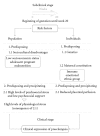Genesis of preeclampsia: an epidemiological approach
- PMID: 22462008
- PMCID: PMC3302023
- DOI: 10.5402/2012/916914
Genesis of preeclampsia: an epidemiological approach
Abstract
THERE ARE ANALYZED SOME OF THE MAIN ASPECTS RELATED TO THE CAUSALITY OF PREECLAMPSIA, PRIVILEGING TWO TYPES OF MODELS: the clinic model and the epidemiologic model, first one represented by the hypothesis of the reduced placental perfusion and the second one considering the epidemiologic findings related to the high levels of psychosocial stress and its association with preeclampsia. It is reasoned out the relevance of raising the causality of the disease from an interdisciplinary perspective, integrating the valuable information generated from both types, clinical and epidemiologic, and finally a tentative explanatory model of preeclampsia is proposed, the subclinical and sociocultural aspects that predispose and trigger the disease are emphasized making aspects to stand out: the importance of reduced placental perfusion as an indicator of individual risk, and the high levels of physiological stress, as a result of the unfavorable conditions of the psychosocial surroundings (indicator of population risk) of the pregnant women.
References
-
- López-Llera M. Complexity and complicity in eclampsia: barriers or bridges? Medical Hypotheses. 1995;45(6):591–601. - PubMed
-
- Dekker G, Sibai B. Primary, secondary, and tertiary prevention of pre-eclampsia. The Lancet. 2001;357(9251):209–215. - PubMed
-
- Roberts JM, Cooper DW. Pathogenesis and genetics of pre-eclampsia. The Lancet. 2001;357(9249):53–56. - PubMed
-
- Luft FC. Pieces of the preeclampsia puzzle. Nephrology Dialysis Transplantation. 2003;18(11):2209–2210. - PubMed
LinkOut - more resources
Full Text Sources
Research Materials


